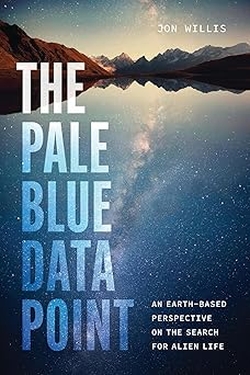Centauri Dreams
Imagining and Planning Interstellar Exploration
Crafting the Interstellar Sail at Delft
Breakthrough Starshot’s concept for a flyby of Alpha Centauri would reach its destination in a single human generation. We’ve discussed sail materials in the last couple of posts, but let’s step back to the overview. Using a powerful ground-based laser, we illuminate a sail on the forward side of which are embedded instruments for communications, imaging and whatever we choose to carry. We need a sail that is roughly 4 meters by 4 meters, and one that weighs no more than a single gram.
As Richard Norte pointed out to the Interstellar Research Group’s Montreal symposium (video here), a US penny weighs 2.5 grams, which gives an idea what we are up against. We need a payload at gram-scale and a sail that is itself no more than a gram. Obviously our sail must be of nanoscale thickness, and able to take a beating, for we’re going to light it up for 10 minutes with that laser beam to drive it to 20 percent of lightspeed. We’re engineering, then, in the realm of nanotechnology, but working on combining our nanoscale components into large objects that can be fabricated at the macro-scale.

This is an uncharted frontier in the realm of precision and microsystems engineering, and it’s one that Norte and his team at Delft University of Technology are pushing into one experiment at a time, with recent funding from the EU and Limitless Space Institute. Things get fascinating quickly at this scale. To make a membrane into a mirror, you puncture your material with nanoscale holes, producing reflectivity at specific wavelengths. The Delft work is with silicon nitride, and in the current thinking of the Starshot team, this material formed as a metagrating is layered between the instruments on the lightsail and the sail body, becoming the means for keeping the sail on the beam and providing attitude control while protecting the instruments.
Image: Delft University of Technology’s Norte, whose lab focuses on novel techniques for designing, fabricating and measuring nanotechnologies needed for quantum optics and mechanics. Credit: Delft University of Technology.
At Delft, as Norte made clear, we’re a long way from achieving the kind of macrostructures that Starshot is looking at, but remember that Starshot is conceived as a multi-decade research effort that will rely on advances along the way. The Delft team is showing us how to make the thinnest conceivable mirror, using machine learning optimization techniques to optimize nanotechnology. The material of choice turns out to be silicon nitride, as we saw in our previous Starshot discussion. Says Norte:
”Of all the material people have used for making photonic crystals, silicon nitride winds up being one of the best. We can make it big, we can make it reflective, we can make it without wrinkles, and it actually has parts per million absorption. This extremely low absorption means we won’t blow this thing up when we shine a laser on it.”
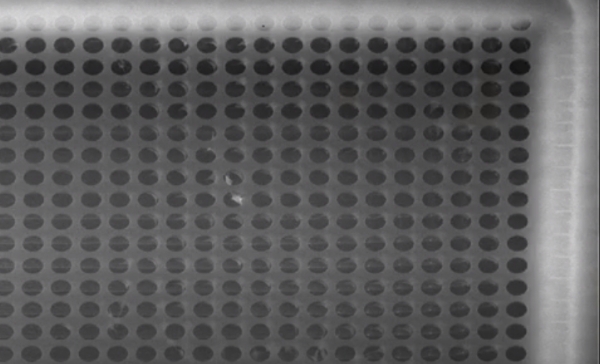
Image: Scanning electron microscope image of a silicon nitride membrane. Credit: Richard Norte/Delft University of Technology. 9:47
The question is how to move to larger mirrors, given that the state of the art when Starshot was announced was at the 350-micron to a side scale. It would be helpful if we could simply ‘stitch’ smaller units together to craft a larger sail, but Norte likens that idea to trying to stitch two soap bubbles together – the structure is so amorphous, filled with the holes of the lattice – that we have to rely on manufacturing techniques that can produce larger wafers rather than combinations of smaller ones.
Scaling up is no small challenge. Norte told the audience at Montreal that his team can now make photonic crystals in the range of 450 mm to the side. The crucial term here is ‘aspect ratio,’ which relates the thickness of a metamaterial to its diameter or width. Interacting with light on the nanoscale means designing around the aspect ratio of these structures to achieve specific nanophotonic effects. Tuning the size and spacing of the holes in the lattice governs the wavelength at which the sail will reflect light.
No less important is the coupling of the laser beam with the sail, because while we are planning to accelerate these sails to speeds that are, by current standards, fantastic, we can only do so by optimizing how they interact with the beam. ‘Alignment resilience’ refers to the reaction of the sail as it is hit by the beam. New ways to arrange the nanoscale holes in the material weigh reflectivity against cost and efficiency, and Norte pointed out that a sail will need to be reflective over a wide range of light, given that it will experience large Doppler shifts in its abrupt change in velocity.
Getting this right will involve considering misalignments between the laser and the sail that can be self-adjusting depending on the design of the mirror lattice, and perhaps faster to accelerate. We seem at the moment to be decades away from being able to make meter-scale photonic crystal lightsails, a daunting thought, but Norte has an exhilarating thought about what we can do today with a sail of the 450 mm size now possible. An Alpha Centauri mission reaches target in centuries, perhaps as few as 200 years. This is assuming a one-gram payload and 70 percent reflectivity.
A wafer size fabrication of 100 mm can be used to build a sail that reaches Voyager 1 distance in 162 days, by Norte’s calculation. Even using the tiny 4.5 cm wafer Delft has already made, we could make that journey in about a year. Using the same 4.5 cm demonstrator alone, we reach Mars with a 1-gram payload in 32 hours, Saturn in 22 days, Uranus in 46 days and Neptune in 74 days. Contrast that with the speed of our fastest flyby probes. Voyager 2 took 12 years, for instance, to reach Neptune.
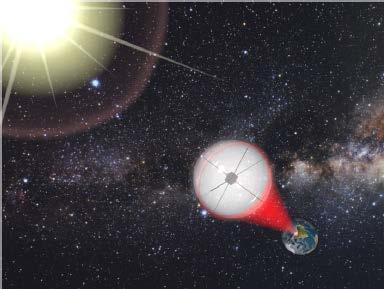
“It’s a compelling thought,” says Norte. “We can. send microchips to Mars the way we send international mail, just shotgunning them out there in 32 hours. Or we can get them to Titan’s oceans in less than a month. This is possible in nanotechnology today.”
Experimental work at Delft involves developing a sail that can be fabricated in a plasma etcher that allows the team to remove the silicon underneath, suspend the structure, and move it (without breaking vacuum) for lift by a laser. The dynamics of the sail under the beam can be explored, as can the question of beam-riding. Out of all this, Norte said, should come new levels of optical levitation, novel structural engineering, a new generation of sensors and detectors. In other words, new material science ahead.

Aerographite and the Interstellar Ark

The science fiction trope that often comes to mind in conjunction with the interstellar ark idea is of the crew that has lost all sense of the mission. Brian Aldiss’ Non-Stop (1958), published in the US as Starship, is a classic case of a generation ship that has become the entire world. The US title, of course, gave away the whole plot, which is sort of ridiculous. Have a look at the British cover, which leaves the setting mysterious for most of the book, and the American one, which blatantly tells you what’s going on. I wonder what Aldiss thought of this.

Be that as it may, interstellar arks are conceived as having large crews and taking a lot of time to move between stars, usually on the order of thousands of years. We can trace the concept in the scientific literature back to Les Shepherd’s famous 1952 paper on human interstellar travel, a key paper in the evolution of the field. An interesting adaptation of the paper appeared in Science Fiction Plus in April of the following year (see The Worldship of 1953). Alan Bond and Anthony Martin, whose names will always evoke Project Daedalus, likewise discussed interstellar arks, and Greg Matloff, whose presentation we looked at in the last post, has been working the numbers on these craft for much of his career.
Let’s look, then, at what Matloff and Joseph Meany say in their paper on aerographite. Here we’re talking about a sailcraft driven by solar photons rather than beamed energy, one that is based on an inflatable, hollow-body sail (itself a concept that goes back at least to the 1980s). Working with Roman Kezerashvili, Matloff has in the past addressed hollow-body sails made of beryllium as well as graphene, last discussing the latter in an interstellar ark concept in 2014. Here he and Meany set up an aerographite-graphene variant using a 90% absorptive and 10% reflective layer of aerographite that effectively pushes against the Sun-facing surface of graphene.
We’re in the realm of big numbers again. The radius of the sail is 764 kilometers, with the sail massing 5.49 X 106 kilograms. The as yet unpublished paper on this work shows that the payload mass (2.56 X 107 kilograms) is considerably higher than would be possible using a hollow-body sail made only of graphene. It’s interesting that for the close solar pass envisioned in the ‘sundiver’ maneuver for the sail, Matloff chooses a perihelion of 0.1 AU in order to hold down the g forces for the human crew. The point came up in the question session after his Montreal talk, for there do seem to be technologies for sustaining (for a short period) g-forces of 3 g and beyond, which would allow for a closer perihelion pass.
In any case, our ark reaches Alpha Centauri in about 1375 years carrying a crew of several hundred. If that figure seems exasperatingly high, consider that in the past few decades we’ve gone from the routine assumption that an interstellar mission would take millennia to the now plausible suggestion that we can get it down to a century or so. Massive arks, of course, take much longer, but this number isn’t bad. NASA’s Les Johnson told me in 2003, when I mentioned a thousand-year mission, that he would love to see a plan for one that could make the journey that fast. But here we are, discussing materials and techniques that can go well below that for unmanned probes. And then there is that Breakthrough Starshot concept of 20 percent of lightspeed…
We are, in other words, making progress. But so much remains to be done with regard to this particular material. Indeed, the work on graphene reminds us how little we know about the physical properties of aerographite. The paper lays out some large questions:
- Will what we know of aerographite’s properties be sustained when we reduce the thickness to a single micron?
- Will aerographite be stable at the temperatures demanded by our perihelion calculations?
- Will aerographite equal the performance of graphene when exposed to the space environment?
- What about trajectory adjustment for a non-reflecting surface like aerographite?
Thus the paper’s conclusion:
It is wise to consider the above discussion as very preliminary. There are many unknowns regarding aerographite and graphene that must be addressed before the missions discussed can be considered feasible.
One unknown is the closest feasible perihelion distance. Just because the Parker Solar Probe will likely survive its close perihelion pass does not mean that a carbon hyper-thin sail will do the same. It is necessary for some researcher to perform an exhaustive study of the effects of the near-Sun space environment upon these substances. A good consideration of the issues to be addressed is the exhaustive study for beryllium solar-photon sails performed by Kezerashvili [9].
One last note on early aerographite sails: What interesting problems they pose for tracking. We’d have to use infrared to follow their course, and a space-based telescope to do that because of infrared absorption in Earth’s atmosphere. Heller and team figured out in their aerographite paper that JWST could track a 1 m aerographite sail out to 2 AU. But swarm configurations (and we’ll be talking about this concept again in the near future) produce a signature that could be detected well beyond the Kuiper Belt. An onboard laser would greatly simplify the problem if we could find ways to power it up aboard the highly miniaturized craft that would be our first experiments.
The paper is Matloff & Meany, ”Aerographite: A Candidate Material for Interstellar Photon Sailing,” submitted to JBIS and ultimately to be published as part of the proceedings of the Interstellar Research Group’s 2023 symposium. The 2014 paper on graphene arks is “Graphene Solar Photon Sails and Interstellar Arks,” JBIS Vol. 67 (June 2014), 237-246 (abstract). The paper on beryllium sails by Roman Kezerashvili is “Thickness Requirements for Solar Sail Foils,” Acta Astronautica 65 (2009), 507-518 (abstract).

Interstellar Sails: A New Analysis of Aerographite
A material called aerographite offers options for solar sails that transcend the capabilities of both beryllium and graphene, the latter being the most recent candidate for fast sail missions outside the Solar System. Developed at the Technical University of Hamburg and refined by researchers at the University of Kiel, aerographite came to the attention of the interstellar community in 2020 thanks to a groundbreaking paper by René Heller (Max Planck Institute for Solar System Research, Göttingen), working with co-authors Guillem Anglada-Escudé (Institut de Ciencies Espacials, Barcelona), Michael Hippke (Sonneberg Observatory, Germany) and Pierre Kervella (Observatoire de Paris).
I’ve written about aerographite before, in Aerographite: An Advance in Sail Materials with Deep Space Implications and Solar Sails: Deeper into the Aerographite Option, both of which are in the archives along with several other posts on the subject. But here I need to pause for a brief administrative moment: The recent changes to the website inadvertently resulted in a data overwrite in the archives that replaced some specialized characters used in scientific notation with question marks. Not good! I have a crack programmer working the fix using my backups, but at the moment the articles I’ve just mentioned do contain several missing characters. This will be remedied soon.
Back to aerographite, where I’m pleased to see this work receiving the further scrutiny it deserves, for this is a highly unusual material, not what you would expect when conceiving deep space missions. As Gregory Matloff and Joseph Meany explain in a new paper discussed at the Interstellar Research Group’s Montreal symposium, aerographite is both extremely low density and utterly opaque. The normal assumption is that an effective solar sail will be reflective (and indeed, graphene concepts include ways to introduce reflectivity, which could be achieved by adding substrates or doping graphene with alkali metals, thus increasing mass).
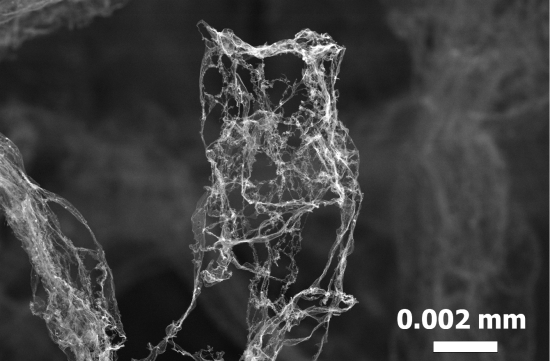
Image; A detail of the world’s lightest material: aerographite. Open carbon tubes form a fine mesh and offer a low density of 0.2 milligram per cubic centimetre. The picture was taken with a scanning electron microscope (SEM). Credit: TUHH.
But the startlingly black aerographite so effectively absorbs photons that in sail configuration it will be pushed into interstellar space. Indeed, Guillem Anglada-Escudé told me three years ago that absorbance works quite well for solar sailing, less effective than a highly reflective material by no more than a factor of 2. As Matloff (New York City College of Technology, CUNY) and Meany (Savannah River National Laboratory) explain in the paper growing out of their work, aerographite is produced by a chemical vapor deposition process that yields a synthetic foam connected by carbon microtubes, one whose opacity is complemented by its light weight. Indeed, the teams that developed it called aerographite “the lightest known material.”
At Montreal, Matloff explored how the material might be deployed in two classes of interstellar missions, looking at such factors as the maximum temperature of the sail at various perihelion distances (for possible ‘sundiver’ missions), the sail’s thermal emissivity, and the peak acceleration that can be achieved, along with payload mass limitations for a 1-micron spherical sail shell and a thin-film payload. The work also probes the characteristics of aerographite under laser beaming conditions, and goes on to examine how it might be deployed in futuristic manned interstellar ‘arks.’ You can see Matloff’s presentation at Montreal here.
Aerographite’s visible photon absorption approaches 100 percent, with high tensile strength and an extremely high melting point. Matloff and Meany’s research involves a hypothetical sail with maximum operational temperature of 3,500 K and a payload mass that is one-tenth of the sail’s. For the purposes of their calculations, they lower the sail’s absorptivity to sunlight to a perhaps more realistic 0.9. Here Matloff’s experience in graphene sails comes in handy, allowing him to use the same analytical tools he and colleague Giovanni Vulpetti have worked out over years of solar sail analysis. Of particular note is the ‘lightness factor,’ which measures solar radiation against acceleration, and which for aerographite works out to an exceptionally high value.
An aerographite sail, in other words, is extremely efficient at converting sunlight into acceleration. The numbers are striking in comparison to previous estimates for solar sailing (as opposed to beaming) technologies. The performance figures in the table below are for an interstellar probe whose sail is unfurled at perihelion during a close solar approach. If you check the perihelion figures used for the analysis, you’ll see that the 0.04 AU figure matches the closest approach of an existing spacecraft, the Parker Solar Probe. And it turns out that 0.06 AU is close to the closest perihelion distance assumed for a beryllium sail. Matloff’s previous analysis of graphene (in a 2014 paper) had assumed a 0.1 AU perihelion for a graphene sail in the same kind of mission.
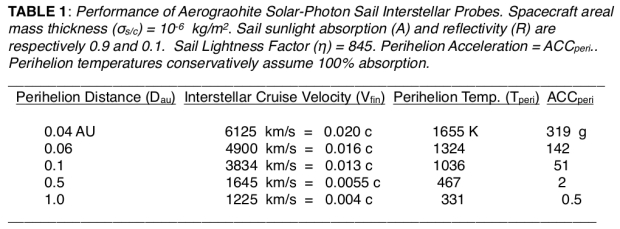
Our probe reaches Proxima Centauri within a millennium for all cases, with the 0.04 AU perihelion probe cutting the travel time to two centuries, a striking figure for a solar sail. The further good news is that according to these calculations, the aerographite at no point exceeds its melting point. Note the huge peak acceleration for the 0.04 AU perihelion pass: 319 g! A sail that makes it through the perihelion pass at 0.04 AU achieves an interstellar cruise velocity of roughly 0.02 c, which we can then stack up against a laser-launched sail along the lines of what Breakthrough Starshot envisions.
Here we run into trouble. From the paper:
It is not clear that an aerographite sail could withstand the enormous accelerations necessary to propel a Project Starshot terrestrial-launched laser-photon sail. Also, such a sail must either have an appropriate curvature to remain within the beam because the beam source moves with Earth’s rotation or be implanted with an appropriate diffraction pattern to optically simulate an appropriately curved sail surface. Also, because aerographite is absorptive rather than reflective, the enormous required beam power on the sail to achieve an ~0.2c interstellar cruise velocity might be fatal.
Which is why Matloff and Meany studied the effects of a sail powered by the beam from a space-based laser array rather than a terrestrial one, using a 100 meter sail for the analysis. I will send you to the paper (or the video) for the details of these calculations, but a laser transmitter of approximately 1.8 kilometers is modeled, with the Sun-orbiting laser at 1 AU from the Sun. Here the craft achieves a velocity of 0.033c given the constraints applied to the beaming technology, which the authors note may be fewer than those imposed on the Starshot array. Indeed:
Constructing sail, sunlight-collection optics and the laser/transmitter are challenging as is the necessity of keeping the sail within the beam during the ~3-hour acceleration run. But these challenges are considerably less than is the case for the Project Starshot relativistic-velocity sails accelerated by a terrestrial laser array.
Those who know Greg Matloff’s work know how he rejoices in stretching ideas out to their maximum potential, much in the mode of Robert Forward. Thus it’s no surprise that the next idea considered here is an aerographite sail capable of carrying humans aboard an interstellar ark. That’s a discussion in itself, and so is the question of the best path forward for aerographite research, two subjects I’ll be taking up in the next post.
The paper is Matloff & Meany, ”Aerographite: A Candidate Material for Interstellar Photon Sailing,” submitted to JBIS and ultimately to be published as part of the proceedings of the Interstellar Research Group’s 2023 symposium. The Heller, Anglada-Escudé, Hippke & Kervella paper is “Low-cost precursor of an interstellar mission,” Astronomy & Astrophysics Vol. 641 (September 2020), A45 (abstract).

An Alternative Take on Fusion Fuel
Let’s talk about fusion fuels in relation to the recent discussion of building a spacecraft engine. A direct fusion drive (DFD) system using magnetic mirror technologies is, as we saw last time, being investigated at the University of Maryland in its Centrifugal Mirror Fusion Experiment (CMFX), as an offshoot of the effort to produce fusion for terrestrial purposes. The initial concept being developed at CMFX is to introduce a radial electric field into the magnetic mirror system. This enhances centrifugal confinement of the plasma in a system using deuterium and tritium as fusion fuel.
Out of this we get power but not thrust. However, both UMD’s Jerry Carson and colleague Tom Bone told the Interstellar Research Group’s Montreal gathering that such a reactor coupled with a reservoir of warm plasma offers prospects for in-space propulsion. Alpha particles (these are helium nuclei produced in the fusion reaction) may stay in the reactor, further energizing the fuel, or they can move upstream, to be converted into electricity by a Standing Wave Direct Energy Converter (SWDEC). A third alternative: They may move downstream to mix with the warm plasma, producing thrust as the plasma expands within a magnetic nozzle.
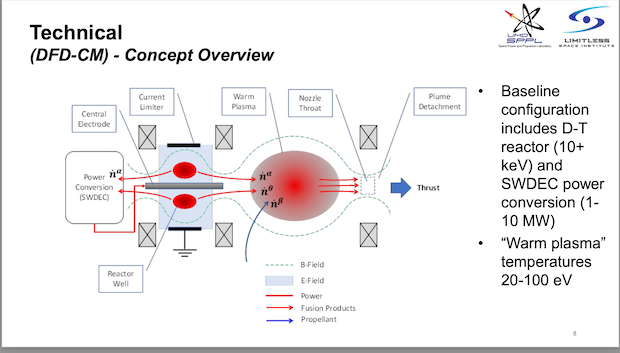
Image: The fusion propulsion system as shown in Jerry Carson’s presentation at IRG Montreal. Thanks to Dr. Carson for passing along the slides.
We also know that fusion fuel options carry their own pluses and minuses. We can turn to deuterium/deuterium reactions (D/D) at the expense of neutron production, something we have to watch carefully if we are talking about powering up a manned spacecraft. The deuterium/tritium reaction (D/T) produces even more neutron flux, while deuterium/helium-3 (D/He3) loses most of the neutron output but demands helium-3 in abundances we only find off-planet. Tom Bone’s presentation at Montreal turned the discussion in a new direction. What about hydrogen and boron?
Here the nomenclature is p-11B, or proton-boron-11, where a hydrogen nucleus (p) collides with a boron-11 nucleus in a reaction that is aneutronic and produces three alpha particles. The downside is that this kind of fusion demands temperatures even higher than D/He3, a challenge to our current confinement and heating technologies. A second disadvantage is the production of bremsstrahlung radiation, which Bone told the Montreal audience was of the same magnitude as the charged particle production.
The German word ‘bremsen’ means ‘to brake,’ hence ‘bremsstrahlung’ means ‘braking radiation,’ a reference to the X-ray radiation produced by a charged particle when it is decelerated by its encounter with atomic nuclei. So p-11B becomes even more problematic as a fuel, given the fact that boron has five electrons, creating a fusion plasma that is a lively place indeed. Bone’s notion is to take this otherwise crippling drawback and turn it to our advantage by converting some of the bremsstrahlung radiation into usable electricity. To do this, it will be necessary to absorb the radiation to produce heat.
Bone’s work at UMD focuses on thermal energy conversion using what is called a thermionic energy converter (TEC), which can convert heat directly into electricity. He pointed out that TECs are a good choice for space applications because they offer low maintenance and low mass coupled with high levels of efficiency. TECs operate off the thermionic emission that occurs when an electron can escape a heated material, a process Bone likened to ‘boiling off’ the electron. An emitter and collector in the TEC thus absorb the heat from the bremsstrahlung radiation to produce electricity.
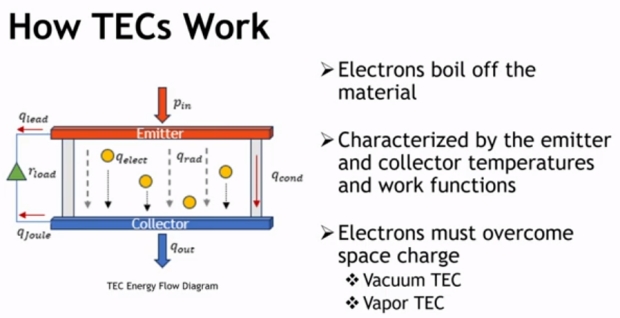
Image: A screenshot from Dr. Bone’s presentation in Montreal.
I don’t want to get any deeper in the weeds here and will send you to Bone’s presentation for the details on the possibilities in TEC design, including putting the TEC emitter and collector in tight proximity with the air pumped out between them (a ‘vacuum TEC’) and putting an ionized vapor between the two (a ‘vapor TEC’). But Bone is upfront about the preliminary nature of this work. The objective at this early stage is to create a basic analytical model for p-11b fuel in a propulsion system using TECs to convert radiation into electricity, with the accompanying calculations to balance power and efficiency and find the lowest bremsstrahlung production for a given power setting.
The scope of needed future work on this is large. What exactly is the best ratio of hydrogen to boron in this scenario, for one thing, and how can the electric and magnetic field levels needed to light this kind of fusion be reduced? “It’s not an easy engineering problem,” Bone added. “It’s certainly not a near-term challenge to solve.”
True enough, but it’s clear that we should be pushing into every aspect of fusion as we learn more about confining these reactions in an in-space engine. Experimenting with alternate fusion fuels has to be part of the process, work that will doubtless continue even as we push forward on the far more tractable issues of deuterium/tritium.

A Fusion Drive Using Centrifugal Mirror Technologies
I want to drop back to fusion propulsion at this point, as it bears upon the question of a Solar System-wide infrastructure that we looked at last time. We know that even chemical propulsion is sufficient to get to Mars, but clearly, reducing travel times is critical if for no other reason than crew health. That likely puts the nuclear thermal concept into play, as we have experience in the development of the technology as far back as NERVA (Nuclear Engine for Rocket Vehicle Application), and this fission-based method shows clear advantages over chemical means in terms of travel times.
It’s equally clear, though, that for missions deep into the Solar System and beyond, the high specific impulse (ISP) enabled by a theoretical direct fusion drive sets the standard we’d like to meet. In his presentation at the Interstellar Research Group’s Montreal symposium, Jerry Carson discussed the ongoing work at the University of Maryland on creating fusion conditions using deuterium/deuterium (D/D) and deuterium/tritium (D/T) fuel with centrifugal mirror confinement. D/T fusion will likely drive our first fusion engines, but its higher neutron flux will spotlight the advantages of helium-3 when the latter becomes widely available, as shielding the crew on a fusion-powered spacecraft will be a critical factor.
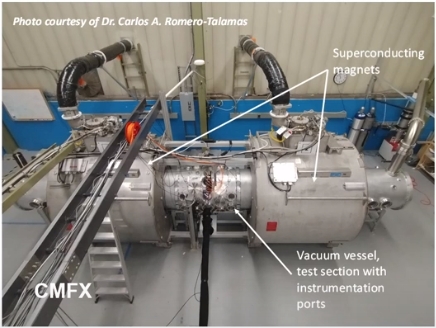
Image: The Centrifugal Mirror Fusion Experiment at the University of Maryland at Baltimore (principal investigator Carlos Romero-Talamás, University of Maryland, Baltimore County). The plan is to achieve fusion conditions (D/D) by 2025. Credit: UMD.
Let’s dig into the centrifugal mirror (CM) concept. The beauty of plasma is that it is electrically conductive, and hence manageable by magnetic and electric fields. Hall thrusters use plasma (though not fusion!), as do concepts like Ad Astra’s VASIMR (Variable Specific Impulse Magnetoplasma Rocket). In a centrifugal mirror, the notion is to confine, compress and heat the plasma as it is spun within a fusion chamber, as opposed to the perhaps more familiar compression methods of inertial fusion, or the magnetic field structures within tokamaks. Carson argues that the CM makes for a more compact reactor and greatly reduces radiation and momentum loss.
The Maryland work implements this effect using magnetic ‘mirrors’ to create the rapid spin that imposes radial and axial forces on the plasma, confining it into a ‘well’ where fusion can be attained. The fuel is bouncing back and forth along the lines of force between the two magnets, a method first explored in the 1950s, when research indicated that mirrors of this kind are leaky and cannot maintain the plasma long enough to ignite fusion. Carson said that it is the addition of an electric field via a central electrode in the UMD design that spins the ‘doughnut’ around its axis, so that the plasma is held in place both axially as well as radially. The basic diagram is below.
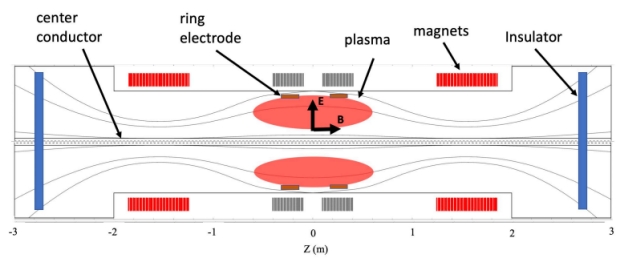
Image: Centrifugal mirror confinement of a high energy plasma. Credit: UMD.
The ongoing work at Maryland grows out of an experimental effort in the 2000s that has led to the current Centrifugal Mirror Fusion Experiment (CMFX). The latter is designed with terrestrial power generation in mind, so we are talking about adapting a power-generating technology into a spacecraft drive. To do that, we fire up a centrifugal mirror fusion reactor in tandem with warm plasma (likely a reservoir of hydrogen, though other gasses are possible), so that high-energy fusion products escape the reactor downstream and deposit their energy in the plasma, causing it to expand as it passes through a magnetic nozzle to produce thrust. The reactor also uses energy leaving the upstream mirror to continue its own operations.
A direct fusion drive of this kind could, Carson said, make the round trip to Mars in 3 months, and reach Saturn in less than three years, a sharp contrast to nuclear electric methods. Even nuclear thermal methods would take over a year to make the Mars mission. Looking further out, the Uranus Orbiter and Probe (UOP), which is being considered as a flagship mission for the upcoming Decadal Survey, would make for a 12 year journey using chemical propulsion and a gravitational assist at Jupiter, while DFD-CM in these specs could do a considerably larger mission to more distant Neptune in as little as 3 years. A second generation Interstellar Probe (50 years to the heliopause in the NASA concept) could reach 1000 AU in 30-35 years using DFD-CM.
We’re not quite through with the University of Maryland, because Carson’s colleague Tom Bone has been analyzing a unique way to take advantage of otherwise problematic bremsstrahlung radiation, which complicates foperations with various kinds of fusion fuels. I’ll run through that work in the next post. Turning this challenging radiation into usable energy is conceivably a possibility, but requires fuel other than the deuterium/tritium combination examined for the DFD-CM drive. Bone’s choice is intriguing, to say the least, but more about this next time.

Infrastructure and the Interstellar Probe
The question of infrastructure haunts the quest to achieve interstellar flight. I’ve always believed that we will develop deep space capabilities not only for research and commerce but also as a means of defense, ensuring that we will be able to change the trajectories of potentially dangerous objects. But consider the recent Breakthrough Starshot discussion. There I noted that we might balance the images we could receive through Starshot’s sails with those we could produce through telescopes at the Sun’s gravitational focus.
Without the infrastructure issue, it would be a simple thing to go with JPL’s Solar Gravitational Lens concept since the target, somewhere around 600 AU, is so much closer, and could produce perhaps even better imagery. But let’s consider Starshot’s huge photon engine in the Atacama desert not as a one-shot enabler for Proxima Centauri, but as a practical tool that, once built, will allow all kinds of fast missions within the Solar System. The financial outlay supports Oort Cloud exploration, fast access to the heliopause and nearby interstellar space, and planetary missions of all kinds. Add atmospheric braking and we can consider it as a supply chain as well.
Robert Freeland, who has labored mightily in the Project Icarus Firefly design, told the Interstellar Research Group’s recent meeting in Montreal about work he is doing within the context of the British Interplanetary Society’s BIS SPACE project, whose goal is to consider the economic drivers, resources, transportation issues and future population growth that would drive an interplanetary economy. That Solar System-wide infrastructure in turn feeds interstellar capabilities, as it generates new technologies that funnel into propulsion concepts. A case in point: In-space fusion.
To make our engines go, we need fuel, an obvious point and a telling one, since the kind of fusion Freeland has been studying for the Firefly design is limited by our current inability to extract enough Helium-3 to use aboard an interstellar craft. Firefly would use Z-pinch fusion – this is a way of confining plasma and compressing it. An electrical current fed into the plasma generates the magnetic fields that ‘pinch,’ or compress the plasma, creating the high temperatures and pressures that can produce fusion.
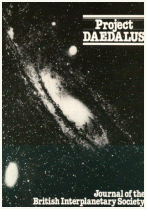
I was glad to see Freeland’s slides on the fusion fuel possibilities, a helpful refresher. The easiest fusion reactions, if anything about fusion can be called ‘easy,’ is that of deuterium with tritium, with the caveat that this reaction produces most of its energies in neutrons that cannot produce thrust. Whereas the reaction of deuterium with helium-3 releases primarily charged particles that can be shaped into thrust, which is why it was D/He3 fusion that was chosen by the Daedalus team for their gigantic starship design back in the 1970s. Along with that choice came the need to find the helium-3 to fuel the craft. The Daedalus team, ever imaginative, contemplated mining the atmospheres of the gas giants, where He3 can be found in abundance.
The lack of He-3 caused Icarus to choose a pure deuterium fuel (DD). Freeland ran through the problems with DD, noting the abundance of produced neutrons and the gamma rays that result from shielding these fast neutrons. The reaction also produces so-called bremsstrahlung radiation, which emerges in the form of x-rays. Thus the Firefly design stripped down what would otherwise be a significant portion of its mass in shielding by going to what Freeland calls ‘distance shielding,’ meaning minimal structure that allows the radiation to escape into space.
A starship using deuterium and helium-3 minimizes the neutron radiation, so the question becomes, when do we close the gap in our space capabilities to the point that we can extract helium-3 in the quantities needed from planets like Uranus? I see BIS SPACE as seeking to probe what the Daedalus team described as a Solar System-wide economy, and to put some numbers to the question of when this capability would evolve. The question is given point in terms of interstellar probes because while Firefly had been conceived as a starship that could launch before 2100, it seemed likely that helium-3 simply wouldn’t be available in sufficient quantities. So when would it be?
To create an infrastructure off-planet, we’ll need human migration outward, beginning most likely with orbital habitats not far from Earth – think of the orbital environments conceived by Gerard O’Neill, with their access to the abundant resources of the inner system. Freeland imagines future population growth moving further out over the course of the next 20,000 years until the Solar System is fully exploited. In four waves of expansion, he sees the era of chemical and ion rocketry, and perhaps beamed propulsion, to about 2050, with the second generation largely using fission-powered craft, in a phase ending in about 2200. 2200 to 2500 taps fusion energies (DD), while the entire Solar System is populated after 2500, with mining of the gas giants possible.
Let’s pause for a moment on the human population’s growth, because the trends noted in the image below, although widely circulated, seem not to be widely known. We’re looking here at the growth rate of our species and its acceleration followed by its long decline. As Freeland pointed out, the UN expects world population to peak at between 10 and 12 billion perhaps before the end of this century. After that, increase in the population is by no means assured. So much for the scenario that we have to go off-planet because we will simply overwhelm resources here with our numbers.
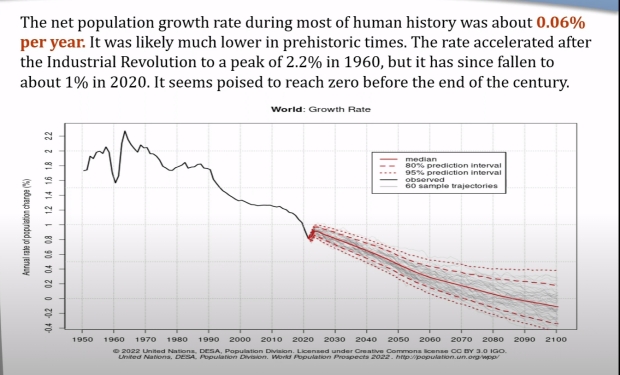
Image: In both this and the image below I am drawing from Freeland’s slides.
You would think this Malthusian notion would have long ago been discredited, but it is surprisingly robust. Even so, orbital habitats near Earth can potentially re-create basic Earth-like conditions while exploiting material resources in great abundance and solar power, with easy access to space for moving the wave of innovation further out. BIS SPACE looks with renewed interest at these O’Neill habitats in its first wave of papers.
The larger scenario plays out as follows: In the second half of our century, we move development largely to high Earth orbit, with materials drawn mostly from the Moon, using transport of goods by nuclear-powered cargo ships. The third generation creates orbital habitats at all the inner planets (and Ceres) and perhaps near-Earth asteroids using DD fusion propulsion, while the fourth generation takes in the outer planets and their moons. At this point we can set up the kind of aerostat mining rigs in the upper gas giant atmospheres that would enable the collection of helium-3. Here again we have to make comparisons with other technologies. Where will beamed spacecraft capabilities be by the time we are actively mining He-3 in the outer Solar System?
I’ve simplified the details on expansion greatly, and send you to Freeland’s slides for the details. But I want to circle back to Firefly. Using DD fusion, Firefly’s radiator and coolant requirements are extreme (480 tonnes of beryllium coolant!) But move to the deuterium/helium-3 reaction and you drop radiation output by 75 percent while increasing exhaust velocity. Beryllium can be replaced with less expensive aluminum and the physical size of the vessel is greatly reduced. This version of Firefly gets to Alpha Centauri in the same time using 1/5th the fuel and 1/12th the coolant.

In other words, the sooner we can build the infrastructure allowing us to mine the critical helium-3, the sooner we can drop the costs of interstellar missions and expand their capabilities using fusion engines. If such a scenario plays out, it will be fascinating to see how the population growth curves for the entire Solar System track given access to abundant new resources and the technologies to exploit them. If we can imagine a Solar System-wide human population in the range of 100 billion, we can also imagine the growth of new propulsion concepts to power colonization outside the system.

